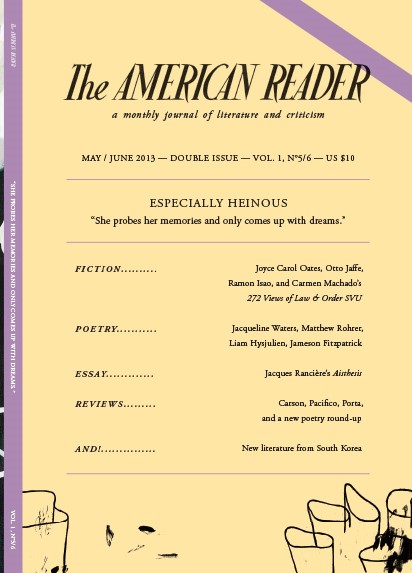Spring 2022
2
Enchanted Fragments
Adrianne Harun, RWW Faculty
Enchanted Fragments

Adrianne Harun
RWW Faculty
Call me scattered. Or shattered. Or perhaps, on a good day, only flighty. In the early spring of 2020, thrown off-kilter by long mourning and persistent trepidation, I found my habit of reading a few books a week unsustainable. To be honest, I found reading difficult. Unable to concentrate, but bound to return again and again to the printed page, my lifelong source of comfort and illumination, I began to despair as longer narratives mostly eluded me. Unread books—long-awaited, greedily anticipated titles—piled up. I glanced. I turned pages. I flitted. But for days, I hardly read. I began to worry that, subsumed as I was by the upcoming election and the ongoing pandemic, I’d retrained myself—or, more accurately, had been retrained—through an obsessive habit of inhaling endless caterwauling scraps of political news to see only data points composed for quick consumption, not contemplation. I was ingesting, not engaging, a deeply discomforting disconnection from my usual experience. The physical and psychic effect was one of peering through uneven cracks, exhausted by the effort to make sense, and I could not help thinking about the Cavern’d Man in William Blake’s “The Marriage of Heaven and Hell”: “If the doors of perception were cleansed every thing would appear to man as it is, Infinite. For man has closed himself up, till he sees all things thro' narrow chinks of his cavern.” This, of course, is a highly uncomfortable place for a writer to reside. If you’re not reading well, you’re likely not writing well either. I felt a little desperate as I wondered how to re-enter the story world in my fractured state.
Stories rely upon magic. Even those of us who have devoted a good part of our lives learning the craft of storytelling, practicing all the ways to pierce and reflect and illuminate and indulge and make fun of and succumb to life through stories, know that a narrative or a plot can’t become a story without magic. Nabokov famously declared a good writer must play three roles: teacher, storyteller, and enchanter, and as a writer, I have both been thrilled and intimidated by that last designation. As a reader, of course, enchantment is pure sustenance, the hidden suddenly made visible, strangely familiar, and unavoidably enticing. Enchantment enfolds in that barely noticed moment when the world falls away and we enter—no, we are in—the story.
“As a reader, of course, enchantment is pure sustenance, the hidden suddenly made visible, strangely familiar, and unavoidably enticing.”
As I tried to reconcile my fractured state with the need for enchantment, I was drawn back to William Kentridge, an artist whose work never fails to jolt me awake, and in the first of his 2012 Norton lectures, “Drawing Lesson One—In Praise of Shadows,” I found a primer on how meaning might evolve from fragments. At one point in his talk, Kentridge presents a group of torn black pieces of paper. At first, as he notes, they are mere shapes against a white paper background, but as he moves them around, we soon see a horse. We know the images are torn black pieces of paper. We also clearly comprehend a horse. As Kentridge points out, they are both there—the crumpled paper and the horse—and he makes an important distinction between knowing and recognizing. In this slight moment, a moment that feels like alchemy, we can recognize without knowing, an act that mimics in a way how we apprehend the world. We see a horse in the paper fragments and reconstruct a sense of horseness. As Kentridge says, “We meet the world halfway. The sheets of paper, those fragments, become a threshold and in that place where the outside world meets memories and associations . . . in some silent vestibule of the brain,” a simultaneous moment of disbelieving and knowing occurs. And this reminded me, too, of a much-garbled quotation from the philosopher George Berkeley, something about the apple having no taste until it touches the tongue. (Bishop Berkeley, you might recall, was the source of the famous query, also deeply paraphrased here: “If a tree falls in the woods, and no one is around to hear it, does it make any sound?”) It seemed increasingly clear to me that one key moment of enchantment arose in that “threshold” moment, that “silent vestibule of the brain,” that instant when a scrap of paper becomes a horse, or when an apple touches the tongue, and a taste comes into being and is named. In other words, magic does not lie solely in the work, but in the meeting of the work and the reader’s expansive private library of memories and sensations.


Adrianne Harun
In the scraps of online information I’d been rabidly consuming, little had been asked of me. My role was prescribed. I was mere “intake,” a receptor meant to take in outrage or sorrow or fear. Most of those emotions appeared but were also muddled as I struggled to bring context to conclusions that had already been set for me. In retrospect, it seems that after hours and hours of subjecting myself to that sort of material, I was truly making the process of reading more difficult. So, I decided to start afresh, like someone who’d nearly lost the sense of taste and hopes to regain it by sampling all sorts of foodstuffs. I stopped reading the news, stopped sampling social media. I went back to an essay I’d once loved . . . and wandered midway. I thrilled at a handful of poems, but soon put the book down, still heartbroken.
At that stage, I’d more or less decided that the problem lay in the presentation of material, in the fragmented approach to which I’d accustomed myself, and wondered if I could use that same form to find my way back to reading. I went to my shelves and eyed a few texts told in modular structures, including, in a spectacular act of intuition, a faded, mostly unread copy of The American Reader’s May/June 2013 issue, with a bookmark left at the opening of Carmen Maria Machado’s novella, “Especially Heinous.”
Can I admit that I felt less intimidated by a journal? I put aside a growing stack of chosen books and opened The American Reader to the bookmarked page.
In “Especially Heinous,” Carmen Maria Machado uses the episodic structure of a culturally insidious television series: Law and Order: Special Victims’ Unit. Of course, the title caught my attention. Law and Order is well-known for cannibalizing news stories, “snatched-from-the-headlines,” to recreate dramas and so seemed right in line with the daily onslaught still clamoring for my attention.
“Can I admit that I felt less intimidated by a journal? I put aside a growing stack of chosen books and opened The American Reader to the bookmarked page.”
Machado begins with Season 1 and moves through each named episode of the show’s first twelve seasons (242 episodes), offering a mere paragraph or two for each as she spins out alternative narratives. (Just read one or two or three, I told myself, before the spell began.) A reader familiar with the show has the immediate thrill of recognizing the show’s catchphrase, “especially heinous,” and the main characters—Benson and Stabler—along with touches of what initially feel like in-crowd humor:
Season 1
“Payback”: Stabler and Benson investigate the murder and castration of a New York City cab driver. They discover that the victim assumed the identity of another man years before because he was wanted by police. In the end, Stabler discovers that the stolen identity of the man in question was also stolen, and he and Benson have to begin the investigation all over again. That night, as he unsuccessfully tries to sleep, Stabler begins to hear a strange noise. A deep drumming, two beats. It seems like it’s coming from his basement. When he investigates the basement, it sounds like it’s coming from outside.
The structure and connection with known characters offer one level of recognition right off the bat for certain readers, but even those who have never watched a single episode of SVU will identify a known situation, much as Kentridge’s viewer perceives a horse out of random shapes of crumpled black paper placed exactly so. The details immediately resound—literally, as the signature sound of the television show (that two-note “dum dum”) underlies the story right from the start. Here, in the opening, it’s funny, but also not a little ominous. A fabulous combination that I felt. I read on.
“Here, in the opening, it’s funny, but also not a little ominous. A fabulous combination that I felt. I read on.”
As the episodes continue, and season gives way to season, Machado introduces wild unknowns and graphic complications into what we’ve taken for granted as entertainment. Girls continue to vanish or be massacred, and Benson and Stabler grow more and more haunted by real ghosts, including, for Benson, a steady mob of murdered girls with bells for eyes. Meanwhile, a pair of more confident and accomplished doppelgangers, Henson and Abler, invade. Desire and sex destroy, heal, and upend, while horrors persist and grow more personal and uncontainable. And still the episodes continue. We can count on that. There are twelve seasons, after all. By the novella’s end, the reader is simultaneously wrung out and horribly exhilarated.
As a gateway back to reading, I don’t think I could have found a more perfect entry point than this brilliant novella. I may have inhaled each disturbing fragment with as much avidity as I did political news, but these fragmented narratives entranced with their cadence of fairy tales and present-time details that were simultaneously precise and emotionally expansive, as in this episode from Season 7:
“Goliath”: Stabler takes another long pull of his whiskey. He slumps in his armchair. Upstairs his wife sleeps, sleeps, dreams, wakes up, sleeps more, hates him, wakes, hates him, sleeps. He thinks of Benson, the way she stood there, the way her clothes looked put on funny, the way she drank from him like she was dying of thirst, the dreamy way her hand ran over the metal fence, over the iron-tipped gate like she was asleep, like she was high, like she was a woman in love, in love, in love.


The American Reader
Can you hear the echoing ruins in “sleeps, sleeps, dreams, wakes up, sleeps more, hates him, wakes, hates him, sleeps” and “like she was asleep, like she was high, like she was a woman in love, in love, in love”? Can you feel the conjuring of threat and deep desire in “she drank from him like she was dying of thirst, the dreamy way her hand ran over the metal fence, over the iron-tipped gate…”? The episodes in “Especially Heinous” opened a space for me, the reader, and all but demanded I slither inside and look and feel and contemplate and, along with Machado, recreate the world and impact of a television show whose weekly content offers human misery as entertainment, as is made evident again and again and even fully voiced in this episode from Season 8:
“Screwed”: The DA calls in sick, again. “The sixty-fifth story,” Henson whispers into her ear, “is about a world which watches you and me and everyone. Watches our suffering like it is a game. Can’t stop. Can’t tear themselves away.”
In the Editor’s Epilogue of this The American Reader issue, Uzoamaka Maduka has a marvelous way of describing this novella’s effect:
“Especially Heinous” belongs to a rare, peculiar, and powerful category of literature . . . what I’ll call, tongue-twistedly, transubstantiationary literature, and it refers to those stories or poems that somehow become exactly what they describe . . . that, in form or execution, increasingly take on the essential qualities of their subjects, themes, and characters, until they actually become them.
“The episodes . . . opened a space for me, the reader, and all but demanded I slither inside and look and feel and contemplate . . .”
Maduka goes on to define transubstantiation further as a kind of process of self-becoming:
For hidden in the Christian conception of transubstantiation, as well as in the faith’s conception of miracles, is the assertion that the thing being transformed always contained within itself a miraculous otherness—in other words, that the thing is not so much transformed as it is revealed to be, essentially, more than itself.
I love this observation because right there, there in that transubstantiation, I see my route in as a reader. Magic, indeed. In the act of reading, I’d become part of that transformation, emotionally creating the story within me as I read. As appalling as the content might be, the act made my heart grow larger. Enchantment took form in the gesture, the glimpse, the voice, the stunning conflation of desire and meaning. Fragments by themselves, but revelations in context and the reader’s remaking. I was curious and engaged, furious and invested, in my view of Machado’s creation, even as I marveled at what was clearly the writer’s highwire magic act.
From Machado’s brilliant novella, I crept into Pale Fire—for me, the Rosetta Stone of fragmented fiction—and swiftly remembered my first reaction on encountering this astounding work years before: pure indignation. Nobody told me! I complained to a good writer friend. Nobody told me Nabokov was funny! I’d felt cheated by my own preconceptions about Nabokov’s work and humbled by my own arrogance. No one can do justice to Pale Fire within the space of an essay. So, here, I will simply say it’s a sui generis marvel. How far do you get into Pale Fire before you realize you are playing alongside Nabokov? Not as cleverly, of course, and with a considerable amount of puzzlement at first, but also with a growing (and wondrous) sense of being able to see in the dark. In retrospect, I’d say, although the reader is barely aware, the epigram pitches the reader right into the game—or is it a chase?
This reminds me of the ludicrous account he gave Mr. Langton, of the despicable state of a young man of good family. ‘Sir, when I heard of him last, he was running around town, shooting cats.’ And then, in a sort of kindly reverie, he bethought himself of his own favorite cat, and said, ‘But Hodge shan’t be shot: no, no, Hodge shan’t be shot.
James Boswell, the Life of Samuel Johnson
“As appalling as the content might be, the act made my heart grow larger. Enchantment took form in the gesture, the glimpse, the voice, the stunning conflation of desire and meaning.”
The novel is divided into five disparate sections, mimicking a certain kind of academic treatise and analysis:
-
- That enigmatic Epigram;
- A Foreword, written by the study’s professed author, Charles Kinbote;
- The Text, a“Poem in Four Cantos” by the eminent poet John Shade, which is the subject of Kinbote’s study;
- Kinbote’s Commentary on the numbered lines within the poem;
- And, finally, an illuminating, contradictory, confounding Index.
We may recognize the outline of this format, but nothing is straightforward in Nabokov’s world. Nothing is what it appears to be at first- or second- or third- or twentieth-glance. Kinbote may be a madman (the crazed Professor Botkin). He most certainly is deranged. (Isn’t he?) Shade’s poem, a heartbreaking account of his daughter’s suicide, is in Kinbote’s perverted analysis, a multi-layered drama of a foreign king on the run from assassins, whose escapades unfold with each fabulously skewed reading of that gorgeous poem’s lines. The commentary morphs into a thriller—the assassin Gradus breaking through fantasy to approach the poet Shade—and the reader, feverishly cross-referencing lines within the poem with Kinbote’s crazed explication (and then the index!) becomes the detective Kinbote is seeking. Language is turned inside out, shaken, and upended, to reveal clue after misleading clue. Soon, we realize we are not only engaged with Shade’s family tragedy and the lovely rhythms of his work, we are well into a Choose Your Own Adventure Book. While Machado uses Law and Order: SVU, Nabokov creates a story framework in Pale Fire through endless self-referencing. Even the potential throwaways of the epigram and index prove engaging and vital and, importantly, confounding. A reader, once engaged, can’t help but become part of the story. Pale Fire is a one-of-a-kind creation that truly should be unreadable or at least come bearing the whiff of gimmickry. Instead, Nabokov’s novel is a jaw-droppingly funny and terrifying tour de force that rewards the kind of close reading that had eluded me for months. Yet, here I was, back in the mix. The closer the reading, the stronger the magic, it seemed.
Now, I think of enchanted fragments as breadcrumbs, leading me back into reading. That spring, I continued randomly drawing one book after another written in that modular form down from my shelves: works from Borges, Carole Maso, Ben Okri, and Lydia Davis; Calvino’s Invisible Cities; Steven Millhauser’s always-thrilling Little Kingdoms; a good half-dozen Rikki Ducornet titles, Doris Lessing’s The Golden Notebook, and B.S. Johnson’s board game of a novel, The Unfortunates. And then, before long, another belated and vital discovery—a remembrance, if you will—that to make a whole out of the fragments, to put something back together out of fragments, is to make something new all of one’s own, that it’s a necessary act of collaboration between writer, text, and reader, and, too, that enchanted fragments can and must appear anywhere, in much-loved mysteries and classics and clamoring debut works, arriving in that single paragraph or gesture or scrap of conversation that cracks open a narrative and puts me, the reader, happily back to work.
Adrianne Harun is the author of two short story collections, The King of Limbo (Houghton Mifflin Mariner) and Catch, Release (Johns Hopkins University Press), and a novel, A Man Came Out of a Door in the Mountain (Penguin). To learn more, visit her website: www.adrianneharun.com.
